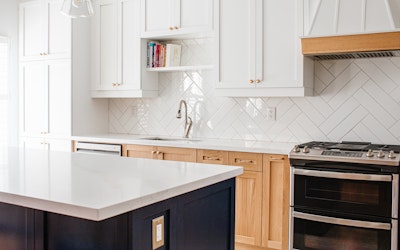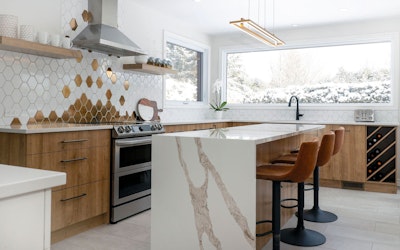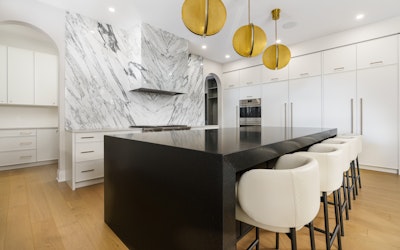Once you’ve allocated a suitable space for the kitchen, it’s time to get started on the layout. The cabinetry, countertops, and islands make up much of the layout. So it’ll make your work easier if you break down your work into a few steps.
Step 1: Features & Requirements.
Step 2: Planning the layout, placement & positioning.
Step 3: Space Optimisation
Step 4: Materials & Finishes
Step 5: Review budget, functionality & safety
These are the fundamental steps we’ll be working on. Feel free to adjust and extend if you need to.
Step 1: Features & Requirements
As you begin, get a clear idea of what type of kitchen you’re crafting first. Based on your preferences, occupation, hobby, and special needs, the kitchen may have different features.
For example, you'll need both an induction and a cooker stove in a kitchen intended for daily cooking. An oven or other appliances are alternative options. If you choose built-in appliances, you may want to have a custom kitchen cabinet design that maximizes the amount of room around the appliance.
But, if you are a home-based professional chef and baker, some parameters may change. A convection oven should be installed in place of the regular oven. Determine whether the built-in kitchen appliances are necessary. In addition, you may require several other appliances, such as heavy-duty mixers, brewing setups, mixing stations, etc.
You can also choose to have fewer cabinets in your kitchen if you don't cook often or just cook on the weekends. Get rid of extra cabinets if you often order takeout. Choose closed shelves so that over time, dust doesn't accumulate.
Step 2: Planning the layout, placement & positioning
After getting a clear idea of your cabinet requirements and appliances, start planning a functional layout and placement. What are the features? How many ovens and sinks do you need? Are they going to be close to the cabinets or in the center aisle? Which height can you comfortably reach?
It’s better if you maintain a safe distance from heat and moisture, both to prevent accidents and make the cabinets last long. Don’t put the top shelves too high if you need to use them frequently. Use them to store rarely used items. You may frequently use some chambers. Keep them close and organized. Ceiling high cabinets are harder to reach, but they also provide ample storage and don’t accumulate dust on top.
Step 3: Space Optimization
After setting the layout, let's see if we can further optimize it based on our features. Regular cooking will call for a fully equipped kitchen with maximum storage. Separate cooking areas will help you make better use of the space in a large, open kitchen. For the best use of available space and the least clutter on countertops, we recommend installing wall and base cabinets.
Another option would be a pull-out storage unit with many cupboards to store bins and jars. Those are also kid-safe since they are too hefty for children to open by themselves! Such units are especially recommended if you wish to maintain a fully stocked kitchen.
We recommend adding plenty of base shelves if you cook rarely or only on holidays. But you may install a lesser number of wall cabinets. This gives the impression that your kitchen is wide and organized. Do you have a large kitchen but don't often make dinner? If so, you could store essential items like coffee powder, alcohol, or even breakfast supplies in the extra kitchen space!
Step 4: Materials & Finishes
Now that you have a perfect cabinet layout in mind, time to choose the materials and finishes. These two are very important for the longevity and aesthetics of your space. We have some answers if you're wondering what materials your kitchen cabinets should be made of.
First of all, the classic plywood shelves with laminate finishes. These are widely used, sufficiently durable, and inexpensive. They’re also easy to customize and replace.
You could look at a kitchen cabinet plan made of stainless steel that has the same material for the countertop and backsplash. It will be beneficial for avoiding extreme heat and humidity. Even better, they can make restorations and cleanings simple. Investing in stainless steel shelving is affordable, particularly if you own a home-based baking or culinary business.
Wooden cabinets with varnish are timeless classics. They boost the appearance of your kitchen, are long-lasting, and recyclable. However, the initial installation may be quite expensive.
Step 5: Review budget, functionality & safety
The aesthetics of your cabinets are important, but so are their functionality, and most importantly, your safety. So recheck and make sure that the design is functional. It should complement the kitchen triangle, letting you quickly access your appliances and move around freely. Check for possible collisions, safety from fire and electricity, and ease of maintenance. Remember, the less dirt and grime it accumulates, the less chores you’ll have.
Last but not least, keep an eye on the money. Materials and finishes have variable prices and all of them may not be locally available. So make all the adjustments you need to your design and budget before handing over the plans to the builder.
Conclusion
With well-designed kitchen cabinetry, you can quickly locate all the things you need. Additionally, you won’t put yourself in awkward situations when trying to locate the correct components for your recipes while cooking. It's important to comprehend the requirements for every kitchen cabinet and create a design that works for your family's lifestyle as well as any special demands.
You May Also Like





